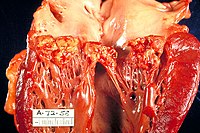
Photo from wikipedia
Abstract Background For infective endocarditis (IE) with extensive perivalvular lesions or end-stage cardiac failure, heart transplantation (HT) may be the last resort. Methods We retrospectively collected all cases of HT… Click to show full abstract
Abstract Background For infective endocarditis (IE) with extensive perivalvular lesions or end-stage cardiac failure, heart transplantation (HT) may be the last resort. Methods We retrospectively collected all cases of HT for IE within the International Collaboration on Endocarditis (ICE) network. Results Between 1991 and 2021, 20 patients (5 women, 15 men), median age 50 years [interquartile range, 29–61], underwent HT for IE in Spain (n = 9), France (n = 6), Switzerland (n = 2), Colombia, Croatia, and USA (n = 1). IE affected prosthetic (n = 10), and native valves (n = 10), primarily aortic (n = 11) and mitral (n = 6). The main pathogens were oral streptococci (n = 8), Staphylococcus aureus (n = 5), and Enterococcus faecalis (n = 2). The major complications included heart failure (n = 18), peri-annular abscess (n = 10), and prosthetic valve dehiscence (n = 4). Eighteen patients had previous cardiac surgery for this episode of IE, and four were on circulatory support before HT (left ventricular assist-device and extra-corporeal membrane oxygenation, 2 patients each). The median time interval between first symptoms of IE and HT was 44.5 days [22–91.5]. The main post-HT complication was acute rejection (n = 6). Seven patients died (35%), four during the first month post-HT. Thirteen (81%) of the 16 patients discharged from the hospital survived with a median follow-up of 35.5 months [4–96.5] after HT, and no relapse of IE. Conclusions IE is not an absolute contraindication for HT: Our case series and the literature review support that HT may be considered as a salvage treatment in highly-selected patients with intractable IE.
Journal Title: Infectious Diseases
Year Published: 2023
Link to full text (if available)
Share on Social Media: Sign Up to like & get
recommendations!